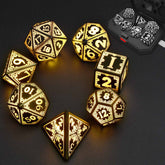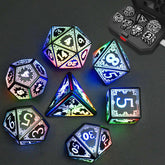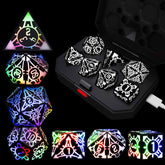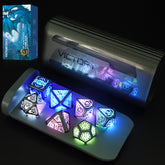What Each DND Dice Is For
In this article, we will provide a detailed introduction to the distinctions among a set of DND dice sets and their various applications in the game.
When we initially joined the DND game, we already possessed a basic grasp of DND gameplay, and we were eager to make our mark in the game world. As we held the finely crafted d&d dice in our hands, we often encountered the question: which dice should we use and when? What distinguishes each dice in various combat situations?
While DND lacks a strictly standardized conclusion, comprehending the use of dice in the game proves immensely beneficial for crafting more captivating game worlds. This marks the outset of our journey into the world of DND gaming.

D4 - Four Sided Dice
D4, a four-sided dice, features values ranging from 1 to 4. It is typically employed for low-variability dice rolls, with a probability of rolling each value at 2.5. This dice is commonly used to calculate damage from smaller weapons, such as daggers. For instance, if you're wielding a dagger, rolling a d4 helps determine your damage output. If you roll a 2, it signifies that you inflicted 2 points of damage in the game. Additionally, the d4 dice is utilized for healing spells, providing benefits to characters in need.
D6 - Six Sided Dice
D6, a six-sided die, features values from 1 to 6. It is commonly utilized in games to determine the damage inflicted by spells and weapons, with a throw probability of 16.67%. For instance, when a wizard casts a fire spell, they roll a d6 to ascertain the amount of damage their spell deals. Additionally, the d6, being a hexahedral die, frequently appears in other tabletop role-playing games (TRPGs).
D8 - Eight Sided Dice
The d8, an eight-sided dice, showcases values ranging from 1 to 8. The d8 dice is employed to calculate moderate damage values, with a throw probability of 12.5%. It serves various functions, including determining hit dice and damage. For instance, priests and druids use a d8 for their hit dice, while weapons such as composite longbows, long swords, and spears also deal d8 damage. Moreover, in the 3rd edition rules, the healing abilities of priests are calculated based on a d8.
D10 - Ten Sided Dice
D10, a ten-sided die, features values from 1 to 10. It is used to determine the damage of specific weapons or spells, and it also serves to calculate hit dice and damage. Paladins, for instance, use a d10 for their hit dice. Heavy crossbows and machetes also rely on a d10 to determine their damage. Compared to the previously mentioned weapons, this category tends to have higher damage values.
D12 - Twelve Sided Dice
D12, a twelve-sided dice, features values from 1 to 12. It's a dodecahedron, and each side has an 8.3% chance of appearing. The primary role of the d12 is typically to calculate damage and determine life values. For example, a barbarian's hit dice are represented by a D12, which is also the highest Hit Dice in the 3rd edition core rules. Furthermore, weapons like giant axes inflict D12 damage. Certain occupations naturally come with higher health points, and the damage potential of different weapons varies, necessitating the use of distinct dice to gauge their effectiveness and potency.

D20 - Twenty Sided Dice
D20, a twenty-sided die, features values from 1 to 20. It's a dice of significant importance, given that the entire game structure of DND is built upon the D20 system. Since the 3rd edition, the DND series has been firmly rooted in the D20 system. Consequently, most values in the game are calculated using the D20. It is the most commonly used die in gameplay. In DND, nearly all our actions rely on the D20 for core calculations. For instance, when faced with a substantial pit, accounting for factors like injuries and weight-bearing, if the difficulty to cross the pit is 14 and our jumping skill is 3, we roll a D20. If we roll an 8 and add our skill of 3, the total is 11, indicating that we fail to jump the pit. Additionally, attack rolls, saving throws, and various other essential calculations all depend on the D20.
D100 - One Hundred Sided Die (Percentile Dice)
D100, also known as the percentile dice, is employed for calculating probability-based events. It consists of two 10-sided dice, labeled D10, with one D10 ranging from 1 to 10 and the other D10 representing multiples of ten from 10 to 100. When determining probability events, if your first dice rolls a 50 and the second dice rolls a 1, you have a 51% probability of succeeding in the task.

Check to know more about Monsters
In the game, you might encounter the abbreviation 'xd4+y' to describe a dice roll, which means 'roll x four-sided dice, sum the results, and add y (resulting in x+y to 4x+y).
- X indicates how many dice to roll (and sum).
- The number after 'd' represents the number of sides on the dice.
- Y represents a bonus or penalty added to the total roll.
Here are some examples:
- 1d8: Roll an eight-sided die, resulting in a value between 1 and 8, representing the damage dealt by a sword.
- 1d8+2: Roll an eight-sided die and add 2, yielding a result between 3 and 10. This accounts for the damage a character with a +2 bonus to Strength can inflict with a longsword.
- 2d4+2: Roll two four-sided dice and add 2, resulting in damage ranging from 4 to 10. This is the damage caused by a level 3 wizard casting a "magic missile"
"Roll for initiative!" - Dungeon Master (DM)
Dungeons & Dragons dice are not merely tools of random chance; they lie at the core of the game, influencing the narrative and the outcome of every adventure. Each type of dice serves a distinct purpose in the game, as illustrated by the examples provided earlier. The role of dice is undeniably significant, and comprehending their functions is essential for both newcomers and seasoned players alike.
To gain a deeper understanding of dice mechanics, players can delve into game manuals, explore additional gaming resources, or engage in discussions with fellow players on various forums. Each dice embodies substantial potential, enabling to craft epic experiences and unforgettable tales within the realm of D&D.
If you're eager to further your understanding of dice usage, here is a video recommendation for you.







